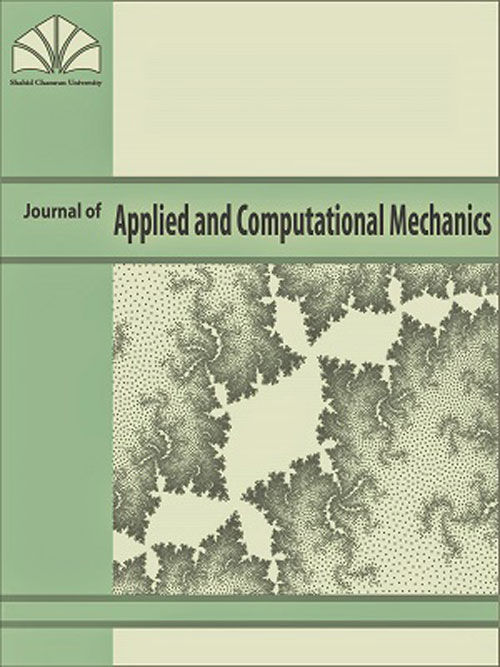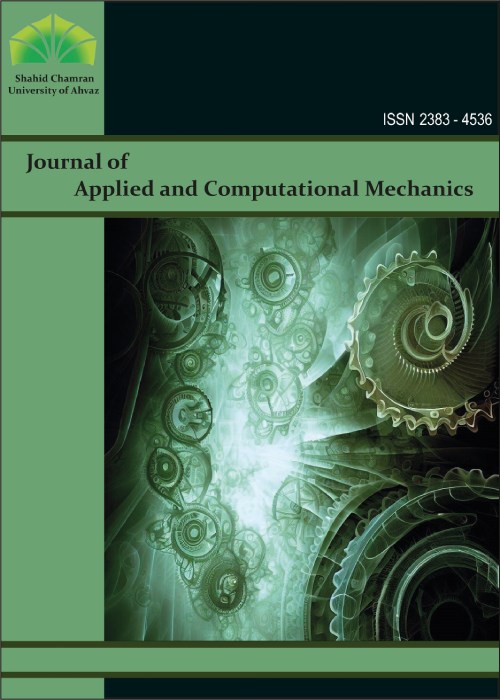فهرست مطالب

Journal of Applied and Computational Mechanics
Volume:4 Issue: 2, Spring 2018
- تاریخ انتشار: 1396/11/17
- تعداد عناوین: 6
-
-
Pages 75-86This study presents a modified continuum model to investigate the vibration behavior of single and multi-carbon nanotubes (CNTs). Two parameters are exploited to consider size dependence; one derived from the energy equivalent model and the other from the modified couple stress theory. The energy equivalent model, derived from the basis of molecular mechanics, is exploited to describe size-dependent material properties such as Young and shear moduli for both zigzag and armchair CNT structures. A modified couple stress theory is proposed to capture the microstructure size effect by assisting material length scale. A modified kinematic Timoshenko nano-beam including shear deformation and rotary inertia effects is developed. The analytical solution is shown and verified with previously published works. Moreover, parametric studies are performed to illustrate the influence of the length scale parameter, translation indices of the chiral vector, and orientation of CNTs on the vibration behaviors. The effect of the number of tube layers on the fundamental frequency of CNTs is also presented. These findings are helpful in mechanical design of high-precision measurement nano-devices manufactured from CNTs.Keywords: Energy Equivalent Model, Modified couple stress theory, Carbon Nanotube, Vibration of Timoshenko Nano Beam, Analytical model
-
Pages 87-94In this paper, the Chebychev spectral collocation method is applied for the thermal analysis of convective-radiative straight fins with the temperature-dependent thermal conductivity. The developed heat transfer model was used to analyse the thermal performance, establish the optimum thermal design parameters, and also, investigate the effects of thermo-geometric parameters and thermal conductivity (nonlinear) parameters on the thermal performance of the fin. The results of this study reveal that the rate of heat transfer from the fin increases as convective, radioactive, and magnetic parameters increase. This study finds good agreements between the obtained results using the Chebychev spectral collocation method and the results obtained using the Runge-Kutta method along with shooting, homotopy perturbation, and Adomian decomposition methods.Keywords: Thermal Analysis, Convective-radiative fin, Chebychev spectral collocation method, Temperature-dependent thermal conductivity
-
Pages 95-104Shock waves generated at different parts of vehicle interact with the boundary layer over the surface at high Mach flows. The adverse pressure gradient across strong shock wave causes the flow to separate and peak loads are generated at separation and reattachment points. The size of separation bubble in the shock boundary layer interaction flows depends on various parameters. Reynolds-averaged Navier-Stokes equations using the standard two-equation k-ω turbulence model is used in simulations for hypersonic flows over compression corner. Different deflection angles, including q ranging from 15o to 38o, are simulated at Mach 9.22 to study its effect on separated flow. This is followed by a variation in the Reynolds number based on the boundary layer thickness, Red from 1x105 to 4x105. Simulations at different constant wall conditions Tw of cool, adiabatic, and hot are also performed. Finally, the effect of free stream Mach numbers M∞, ranging from 5 to 9, on interaction region is studied. It is observed that an increase in parameters, q, Red, and Tw results in an increase in the separation bubble length, Ls, and an increase in M∞ results in the decrease in Ls.Keywords: High speed flows, shock-boundary-layer interaction, hypersonic flows, Shock-waves, Boundary-layer, compression corner, Computational Fluid Dynamics
-
Pages 105-114In the present study, the finite element method is developed for the static analysis of nano-beams under the Winkler foundation and the uniform load. The small scale effect along with Eringen's nonlocal elasticity theory is taken into account. The governing equations are derived based on the minimum potential energy principle. Galerkin weighted residual method is used to obtain the finite element equations. The validity and novelty of the results for bending are tested and comparative results are presented. Deflections according to different Winkler foundation parameters and small scale parameters are tabulated and plotted. As it can be seen clearly from figures and tables, for simply-supported boundary conditions, the effect of small scale parameter is very high when the Winkler foundation parameter is smaller. On the other hand, for clamped-clamped boundary conditions, the effect of small scale parameter is higher when the Winkler foundation parameter is high. Although the effect of the small scale parameter is adverse on deflection for simply-supported and clamped-clamped boundary conditions.Keywords: Nonlocal elasticity theory, Static Analysis, Weighted residual method, Winkler foundation, Euler-Bernoulli beam theory
-
Pages 115-124The present study investigates buckling characteristics of both nonlinear symmetric power and sigmoid functionally graded (FG) beams. The volume fractions of metal and ceramic are assumed to be distributed through a beam thickness by the sigmoid-law distribution (S-FGM), and the symmetric power function (SP-FGM). These functions have smooth variation of properties across the boundary rather than the classical power law distribution which permits gradually variation of stresses at the surface boundary and eliminates delamination. The Voigt model is proposed to homogenize micromechanical properties and to derive the effective material properties. The Euler-Bernoulli beam theory is selected to describe Kinematic relations. A finite element model is exploited to form stiffness and buckling matrices and solve the problem of eignivalue numerically. Numerical results present the effect of material graduations and elasticity ratios on the buckling behavior of FG beams. The proposed model is helpful in stability of mechanical systems manufactured from FGMs.Keywords: Static Stability, Buckling, Functional graded materials, Symmetric Power-Law, Sigmoid Function, Finite element
-
Pages 125-132In this paper we develop a numerical procedure using finite element and augmented Lagrangian meth-ods that simulates electro-mechanical pull-in states of both cantilever and fixed beams in microelectromechanical systems (MEMS) switches. We devise the augmented Lagrangian methods for the well-known Euler-Bernoulli beam equation which also takes into consideration of the fringing effect of electric field to allow a smooth transi-tion of the electric field between center of a beam and edges of the beam. The numerical results obtained by the procedure are tabulated and compared with some existing results for beams in MEMS switches in literature. This procedure produces stable and accurate numerical results for simulation of these MEMS beams and can be a useful and efficient alternative for design and determining onset of pull-in for such devices.Keywords: Microelectromechanical switch, pull-in, microbeam, finite element solutions, Augmented Lagrangian methods


